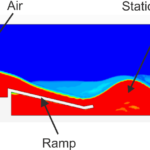HPC User Report from S. Falk (Division of Phoniatrics and Pediatric Audiology)
Numerical study on a stationary wave for surfing
Computational fluid dynamics (CFD) is used to simulate a stationary surfable wave. The project aims to develop a suitable simulation model, which can reproduce a Eulerian multiphase of air and water and create a stationary wave by water running down a ramp.
Motivation and problem definition
Surfing is well known as a sport at the coasts of Hawaii, Australia and California. Many surfers do not live next to the ocean where they can easily go surfing every day. Soon, resourceful surfers began to surf so-called stationary waves in rivers. The most famous river wave is the Eisbach-Welle in the center of Munich. This wave arises because of a constructional error at the Eisbach river. In other cities, artificial waves are promoted to allow such river surfing; e.g. Dauerwelle e.V. in Nuremberg in the Pegnitz river.
Using CFD can help to fully understand the mechanisms that are responsible for the emergence of a stationary artificial wave. By performing CFD simulation, we want to understand the mechanisms and relevant parameters of such artificial waves. This will be the basis for future studies, where actual ocean surfspot setups will be simulated to increase our understanding of the occurring processes.
Methods and codes

Unsteady Reynolds-averaged Navier-Stokes equations using the SST K-Omega model in combination with a Eulerian multiphase model were performed using the finite volume method fully integrated into the commercial software package STAR-CCM+ (Siemens). A simplified stream current including a ramp and a step was inserted in a three-dimensional rectangular fluid volume. The stream current has a defined inflow velocity, and firstly the ramp is fixed. After conducting a grid independence study, a basic simulation model with 2.6 million cells was found and makes the use of high-performance computing (HPC) systems inevitable. Therefore, four computer nodes of RRZE’s Emmy cluster are used to perform the simulations in this study.
Results

During some test runs and the grid independence study, it was found that there is a significant relationship between the inflow velocity of the stream current, the volume flow of the water over the ramp and the water height downstream of the ramp to produce an adequate stationary wave.
Outreach
The project is running since November 2018.
Cooperation
Univ.-Prof. Dr.-Ing. habil. Markus Aufleger – Arbeitsbereich Wasserbau am Institut für Infrastruktur at the University of Innsbruck: Experimental counterpart to the numerical simulations
Researcher’s Bio and Affiliation
Sebastian Falk obtained his Master degree in Mechanical Engineering at the Friedrich-Alexander University Erlangen-Nürnberg (FAU) and is currently a PhD student and scientific assistant under the supervision of PD Dr.-Ing. Stefan Kniesburges and Prof. Dr.-Ing. Michael Döllinger (Head of research) at the division of Phoniatrics and Pediatric Audiology at the Department of Otorhinolaryngology, Head and Neck Surgery of University Hospital Erlangen and Medical Faculty of FAU.
